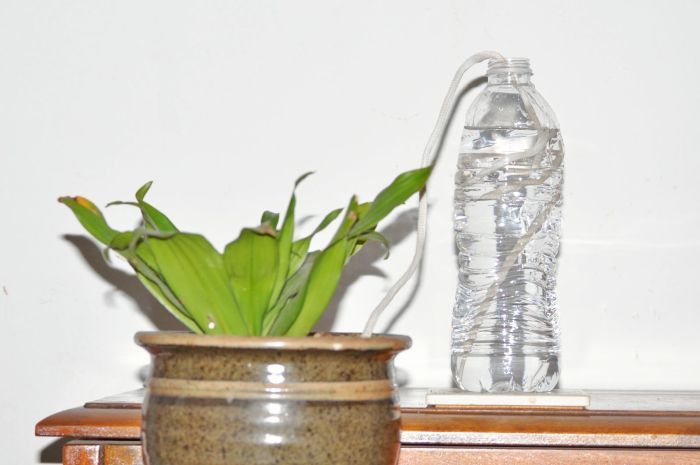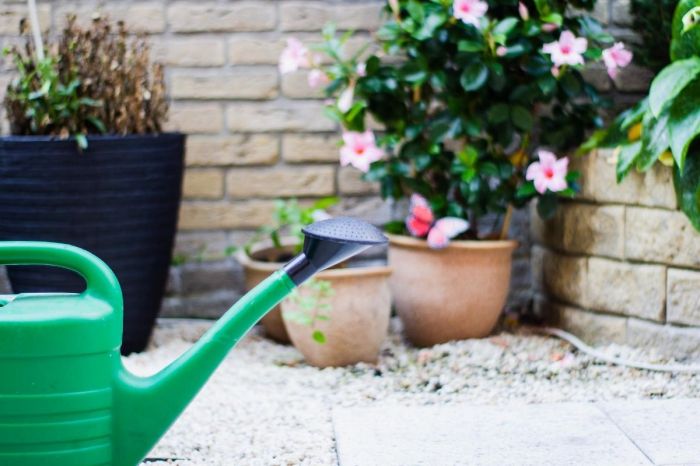How Do I Water Plants While on Vacation?
Automatic Watering Systems
How do i water plants while on vacation – Automatic watering systems offer a convenient solution for maintaining plant hydration during extended absences. Several options cater to different needs and budgets, ranging from simple self-watering devices to more complex drip irrigation setups.
Types of Automatic Watering Systems
Three common types of automatic watering systems for home use include drip irrigation, soaker hoses, and self-watering globes. Each offers unique advantages and disadvantages.
| System Type | Pros | Cons | Suitability |
|---|---|---|---|
| Drip Irrigation | Precise water delivery, efficient water use, suitable for various plants and sizes. | Higher initial cost, requires more setup and maintenance. | Larger gardens, established plants, diverse plant needs. |
| Soaker Hoses | Easy installation, relatively inexpensive, good for larger areas. | Less precise water distribution, can lead to overwatering in some areas. | Vegetables, flower beds, ground cover. |
| Self-Watering Globes | Simple to use, inexpensive, ideal for individual plants. | Limited water capacity, not suitable for large plants or extended absences (more than a week). | Potted plants, small gardens. |
Drip Irrigation System Installation
Installing a basic drip irrigation system involves several steps. First, plan the layout based on plant locations and water needs. Next, assemble the components: a water source (e.g., a garden hose), a pressure regulator (to prevent overwatering), tubing, emitters (to deliver water directly to plant roots), and connectors. Finally, connect the components, ensuring a secure and leak-free system.
Regularly check for leaks and adjust emitters as needed.
Self-Watering Planter Box Design
A simple self-watering planter box can be constructed using a container with a reservoir at the bottom, separated from the planting area by a layer of gravel or other porous material. The reservoir holds water, which is drawn up by capillary action into the planting medium as needed. A wicking system can enhance water distribution. A diagram would show a container with a bottom reservoir, a layer of gravel, potting mix, and plants, illustrating the water flow.
Manual Watering Techniques
For shorter absences, manual watering techniques can suffice. The effectiveness of each method depends heavily on the soil type and plant species.
Manual Watering Methods
Three effective methods for manually watering plants for up to a week include deep watering before departure, using water-retaining materials, and employing a slow-release watering system using bottles or other containers.
- Deep Watering: Thoroughly saturate the soil before leaving to provide a water reserve.
- Water-Retaining Materials: Incorporate materials like peat moss or hydrogel into the soil to improve water retention.
- Slow-Release Watering: Create a slow-release system by inverting bottles filled with water, burying the neck in the soil. The water will slowly seep out.
Soil Type and Plant Species Considerations
Clay soils retain water longer than sandy soils, requiring less frequent watering. Succulents and cacti require less frequent watering than tropical plants. Consider these factors when selecting a watering method. For instance, cacti in sandy soil may only need a single deep watering before a week-long absence, while a fern in clay soil might need a more elaborate slow-release system.
Preparing Plants for Absence (Watering Can Method)
- Water thoroughly the day before departure, ensuring the soil is deeply saturated.
- Group plants with similar watering needs together for easier management.
- Mulch the soil surface to reduce evaporation.
- Consider using self-watering globes or similar devices for individual plants requiring more attention.
Suitable Containers for Water Retention
Terracotta pots generally dry out faster than plastic or glazed ceramic pots. Larger containers tend to retain moisture longer than smaller ones. Choose containers based on plant needs and the length of your absence. A chart showing water retention capacity for different container types and sizes would be beneficial.
Choosing Vacation-Proof Plants
Selecting low-maintenance plants simplifies care while you’re away. Consider factors like water requirements and tolerance to varying conditions.
Low-Maintenance Houseplants
- Snake Plant
- ZZ Plant
- Cast Iron Plant
- Aloe Vera
- Spider Plant
Succulents vs. Tropical Plants
Succulents are adapted to arid conditions and store water in their leaves and stems, requiring infrequent watering. Tropical plants generally need consistently moist soil and higher humidity levels. A comparison table highlighting water frequency and environmental needs would be helpful.
Grouping Plants for Easier Watering
Grouping plants with similar watering needs together simplifies watering and allows for more efficient water management. This also improves the overall visual appeal by creating cohesive plant displays.
Creating a Visually Appealing Arrangement

Source: thespruce.com
Arrange drought-tolerant plants in a visually appealing way, perhaps using contrasting textures, colors, and heights. Consider using different sized pots and containers to create a dynamic display. A description of a visually appealing arrangement of succulents, cacti, and other drought-tolerant plants would be beneficial.
Preparing Plants Before Leaving
Proper preparation ensures your plants thrive in your absence. This includes thorough watering, mulching, and protection from harsh sunlight.
Thorough Pre-Vacation Watering
Water plants deeply the day before departure. The amount of water needed varies depending on the plant, pot size, and soil type. Ensure the soil is thoroughly saturated but not waterlogged.
Mulching for Moisture Retention
Applying a layer of mulch (e.g., wood chips, straw) around plants helps retain soil moisture and reduces evaporation. The mulch layer should be a few inches thick but not touching the plant stems.
Creating a Humidity Dome, How do i water plants while on vacation
For moisture-loving plants, create a humidity dome by covering the plant with a clear plastic bag or a cloche. This helps maintain humidity levels and prevents excessive drying.
Protecting Plants from Sunlight
Move plants away from direct sunlight during extended absences to prevent scorching and wilting. Consider using blinds or curtains to filter the sunlight or placing plants in a shadier location.
Seeking Help While Away
Enlisting a friend or neighbor’s assistance can provide peace of mind. Clear communication is key to successful plant care while you’re away.
Plant-Sitting Checklist

Source: beadnova.com
A checklist for asking a friend or neighbor to water plants should include plant locations, watering frequency, specific plant care needs (e.g., humidity requirements), and contact information in case of emergencies.
Instructions for a Plant Sitter
- Watering schedule for each plant.
- Specific watering instructions (e.g., amount of water, watering method).
- Any special care requirements (e.g., fertilization, pest control).
- Contact information in case of problems.
Clear Communication
Provide clear and concise instructions, including pictures if necessary. Consider creating a detailed plant care guide with photos and instructions for each plant.
Sample Email Template
Subject: Plant Sitting Request – [Your Name]
Hi [Friend’s Name],
I’m going on vacation from [Start Date] to [End Date] and would greatly appreciate your help in watering my plants. I’ve attached a document with a detailed care guide, including watering schedules and specific instructions for each plant. Please let me know if you’re available and if you have any questions.
Thanks so much!
[Your Name]
[Your Contact Information]
FAQ Compilation: How Do I Water Plants While On Vacation
What if I forget to water my plants before leaving?
While thorough pre-vacation watering is ideal, even if you forget, many plants can survive a few days without watering, especially if the soil is well-draining. Consider using a watering technique like the soil-soaking method, even at the last minute, to provide extra moisture.
Can I overwater my plants using an automatic system?
Yes, it’s possible. Always choose a system appropriate for your plant’s needs and adjust the watering frequency according to the weather and soil conditions. Regularly check your plants, even with an automatic system, to prevent overwatering.
What if my plant sitter cancels at the last minute?
Have backup plans! Consider a neighbor, family member, or even a local plant care service. Communicate clearly and offer compensation to ensure someone is available to tend to your plants.
Are there any apps that can help manage plant watering?
Yes, several apps offer reminders and scheduling features for plant watering. Research apps that allow customization based on plant type and your schedule.




















